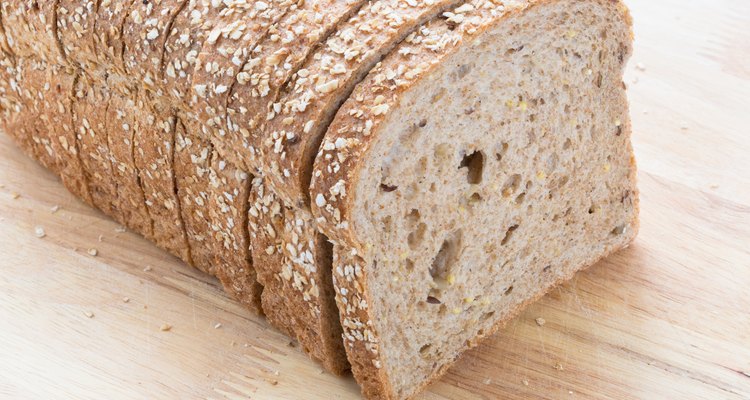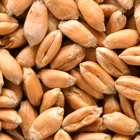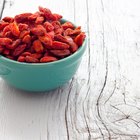
MariuszBlach/iStock/Getty Images
It’s easy to be fooled by the name, but wheat berries aren’t real berries at all. They're part of the whole wheat kernel, and they pack a powerful nutritional punch. Wheat berries can be eaten on their own, but are more commonly used to make bread products. If you’re concerned about what foods you should eat for optimal health, adding wheat berry bread to your menu is a smart choice.
Identification
Wheat berry is composed of the complete unprocessed wheat kernel except for the hull, and includes the bran, germ and starchy endosperm. Wheat berries retain all of the grain's vitamins, minerals and other nutrients. Wheat berries have three main varieties: hard red spring or hard red winter, which are high in protein, brown and used to make bread flour; hard white, with a hard kernel and pale color, used for bread and brewing; and soft white, with a softer kernel, used to make pastry flour.
Nutrition
Wheat berries are high in fiber, and also contain protein; vitamins; minerals such as manganese, selenium, phosphorus and magnesium; and lignans, which are phytochemicals that have been studied for their potential to guard against breast and prostate cancers. There are several manufacturers of wheat berry bread with different brands on the market. The bread's nutritional content varies, according to the additional ingredients included. An average slice of wheat berry bread contains 100 to 110 calories, with one gram of polyunsaturated fat, 22 grams of carbohydrates, 150 milligrams of sodium, six grams of protein, three grams of fiber and four grams of sugar.
Benefits
Whole grains such as wheat berries may help lower your risk of heart disease, type 2 diabetes and certain cancers. Journalist and registered dietitian Leslie Beck also points to a study published in 1999 in the “American Journal of Clinical Nutrition” that followed the eating habits of over 70,000 women in the Nurses' Health Study II. The study discovered that subjects who ate the most whole grains typically weighed less than those who ate the fewest whole grains.
Expert Insight
Researchers at Wake Forest University School of Medicine, led by Philip Mellen, M.D., conducted a meta-analysis of seven studies involving more than 285,000 people. Their study, published in “Nutrition, Metabolism & Cardiovascular Disease,” found that people who consumed an average of 2.5 servings of whole grains daily had a 21 percent lower risk of cardiovascular disease compared with those who only had 0.2 servings per day.
Considerations
Many people make homemade wheat berry bread, using wheat berries from health food stores. To prepare the wheat berries, combine them with water in a covered sauce pan, and let them soak for an hour. Then cook on medium heat, stirring occasionally, until the wheat berries are soft and pop open. Once they’re cooled, they can be added to the regular bread dough. An alternate preparation method is to place wheat berries in a jar filled with lukewarm water, soak for two hours, drain, rinse and then cover and store in a dark place for two to four days.
Warning
Wheat berries contain gluten, so you should avoid them if you’re a celiac patient or gluten intolerant. Hard wheat berries tend to have the highest gluten content of the three basic types of wheat berries.
Related Articles

How to Freeze Dewberries

How to Cook Soft Wheat Berries

How to Make Elderberry Jam

How to Make Toasted Bread Sticks With ...

How Long Does Banana Bread Stay Fresh?

How to Make Pumpernickel Flour

How to Make Fresh Strawberry Frosting ...

How to Marinate Strawberries

How to Freeze Fresh Raw Coconut

What Is White Oat?

Goji Vs. Blueberries

How Much Whole Grain Should You Eat a ...

Number of Calories in Dark ...

Tayberry Jam Recipe

How to Blanch Cashews

Alternative Flours to Make Pizza

How to Add Fresh Cranberries to Any ...

Psyllium Husk & Gluten

Can I Use Egg Roll Wraps for Making ...

How to Freeze Raspberries
References
Writer Bio
Bonnie Singleton has been writing professionally since 1996. She has written for various newspapers and magazines including "The Washington Times" and "Woman's World." She also wrote for the BBC-TV news magazine "From Washington" and worked for Discovery Channel online for more than a decade. Singleton holds a master's degree in musicology from Florida State University and is a member of the American Independent Writers.
Photo Credits
MariuszBlach/iStock/Getty Images